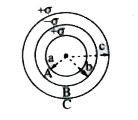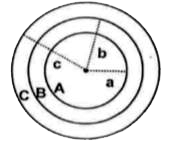Three concentric spherical metallic shells A,B,andC of radii a,b,andc(a<b<c) have surface charge densities σ,−σ and σ, respectively.
If VA,VB and VC are potential of shells A, B and C, respectively, match the columns
Column AColumn Ba.VAi.σε0[a2−b2+c2c]b.VBii.σ2ε0[a2b−b+c]c.VCiii.σε0[a−b+c]
To solve the problem, we need to find the electric potentials VA, VB, and VC for the three concentric spherical shells A, B, and C with given surface charge densities. Let's go through the steps systematically.
Step 1: Determine the Charge on Each Shell
1. Shell A:
- Surface charge density σ
- Radius a
- Charge QA=σ×Area=σ×4πa2
2. Shell B:
- Surface charge density −σ
- Radius b
- Charge QB=−σ×Area=−σ×4πb2
3. Shell C:
- Surface charge density σ
- Radius c
- Charge QC=σ×Area=σ×4πc2
Step 2: Calculate the Potential VA
The potential VA at shell A due to all three shells is given by:
VA=k(QAa+QBb+QCc)
Substituting the values of QA, QB, and QC:
VA=14πϵ0(σ⋅4πa2a+−σ⋅4πb2b+σ⋅4πc2c)
This simplifies to:
VA=σϵ0(a−b+c)
Thus, VA=σϵ0(a−b+c).
Step 3: Calculate the Potential VB
The potential VB at shell B is given by:
VB=k(QAb+QBb+QCc)
Substituting the values:
VB=14πϵ0(σ⋅4πa2b+−σ⋅4πb2b+σ⋅4πc2c)
This simplifies to:
VB=σϵ0(a2b−b+c)
Step 4: Calculate the Potential VC
The potential VC at shell C is given by:
VC=k(QAc+QBc+QCc)
Substituting the values:
VC=14πϵ0(σ⋅4πa2c+−σ⋅4πb2c+σ⋅4πc2c)
This simplifies to:
VC=σϵ0(a2c−b2c+c)
Step 5: Match the Results
Now we can match the potentials with the options provided:
- VA=σϵ0(a−b+c) corresponds to option iii.
- VB=σϵ0(a2b−b+c) corresponds to option ii.
- VC=σϵ0(a2c−b2c+c) corresponds to option i.
Final Matching
- VA → iii
- VB → ii
- VC → i
1. Shell A:
- Surface charge density σ
- Radius a
- Charge QA=σ×Area=σ×4πa2
- Surface charge density −σ
- Radius b
- Charge QB=−σ×Area=−σ×4πb2
- Surface charge density σ
- Radius c
- Charge QC=σ×Area=σ×4πc2
The potential VA at shell A due to all three shells is given by:
VA=k(QAa+QBb+QCc)
Substituting the values of QA, QB, and QC:
VA=14πϵ0(σ⋅4πa2a+−σ⋅4πb2b+σ⋅4πc2c)
This simplifies to:
VA=σϵ0(a−b+c)
Thus, VA=σϵ0(a−b+c).
The potential VB at shell B is given by:
VB=k(QAb+QBb+QCc)
Substituting the values:
VB=14πϵ0(σ⋅4πa2b+−σ⋅4πb2b+σ⋅4πc2c)
This simplifies to:
VB=σϵ0(a2b−b+c)
The potential VC at shell C is given by:
VC=k(QAc+QBc+QCc)
Substituting the values:
VC=14πϵ0(σ⋅4πa2c+−σ⋅4πb2c+σ⋅4πc2c)
This simplifies to:
VC=σϵ0(a2c−b2c+c)
Now we can match the potentials with the options provided:
- VA=σϵ0(a−b+c) corresponds to option iii.
- VB=σϵ0(a2b−b+c) corresponds to option ii.
- VC=σϵ0(a2c−b2c+c) corresponds to option i.
- VA → iii
- VB → ii
- VC → i
Topper's Solved these Questions
- ELECTRIC POTENTIALBook:CENGAGE PHYSICS ENGLISHChapter:ELECTRIC POTENTIALExercise:Integer
Explore 5 Videos
- ELECTRIC POTENTIALBook:CENGAGE PHYSICS ENGLISHChapter:ELECTRIC POTENTIALExercise:DPP 3.1
Explore 14 Videos
- ELECTRIC POTENTIALBook:CENGAGE PHYSICS ENGLISHChapter:ELECTRIC POTENTIALExercise:Multiple Correct
Explore 10 Videos
- ELECTRIC FLUX AND GAUSS LAWBook:CENGAGE PHYSICS ENGLISHChapter:ELECTRIC FLUX AND GAUSS LAWExercise:MCQ s
Explore 38 Videos
- ELECTRICAL MEASURING INSTRUMENTSBook:CENGAGE PHYSICS ENGLISHChapter:ELECTRICAL MEASURING INSTRUMENTSExercise:M.C.Q
Explore 2 Videos
Similar Questions
Three concentric spherical metallic spheres A,B and C of radii a,b and c(a<b<c) have surface charge densities σ,−σ and σ respectively.
View SolutionThree concentric metallic spherical shells A,B and C of radii a,b and c(a<b<c) have surface charge densities +σ,−σand +σ respectively ,the potential of shell B is
View Solution
Knowledge Check
Three concentric spherical shells have radii a,b and c(a<b<c) and have surface charge densities σ,−sigam and σ respectively. If VA,VB and VC denote the potentials of the three shells, then for c=a+b, we have
AVC=VB=VABVC=VA≠VBCVC=VB≠VADVC≠VB≠VA
Three concentric spherical shells have radii a,b and c(a<b<c) and have surface charge densities σ,−σ and σ respectively. If VA,VB and VC denote the potentials of the three shells, then for c=q+b, we have
View SolutionThree concentric metallic spherical shell A,B and C or radii a,b and c(a<b<c) have surface charge densities −σ,+σand−σ. Respectively. The potential of shel A is :
View SolutionThree concentric spherical metal shells A.B.C of radii a,b,c(c>b>a) have surface charge density +σ,−σand+σ respectively. The potential of the middle shell is σε0 times

View SolutionThree concentric spherical metallic shells A,B and C of radii a,b and c (a<b<c) have surface charge densities σ,−σandσ respectively.
If the potential of shell B is VB=σ∈0(anb−b+c) and the potential of shell C is VC=σ∈0(anc−bnc+c) then n is .
View SolutionThree concentric charged metallic spherical shells A, B and C have radii a,b and c, charge densities σ,−σ and σ and potentials VA,VB and VC respectively. Then which of the following relations is correct?

View SolutionThree concentric spherical metallic shells A, B and C of radii a, b and c (a < b < c) have surface charge densities σ, −σ and σ respectively.
(i) Find the potential of the three shells A, B and C.
(ii) If the shells A and C are at the same potential, obtain the relation between the radii a, b and c.
View SolutionFigure shows three concentric thin spherical shells A, B and C of radii a, b, and c. The shells A and C are given charge q and -q, respectively, and shell B is earthed. Then,
View Solution
